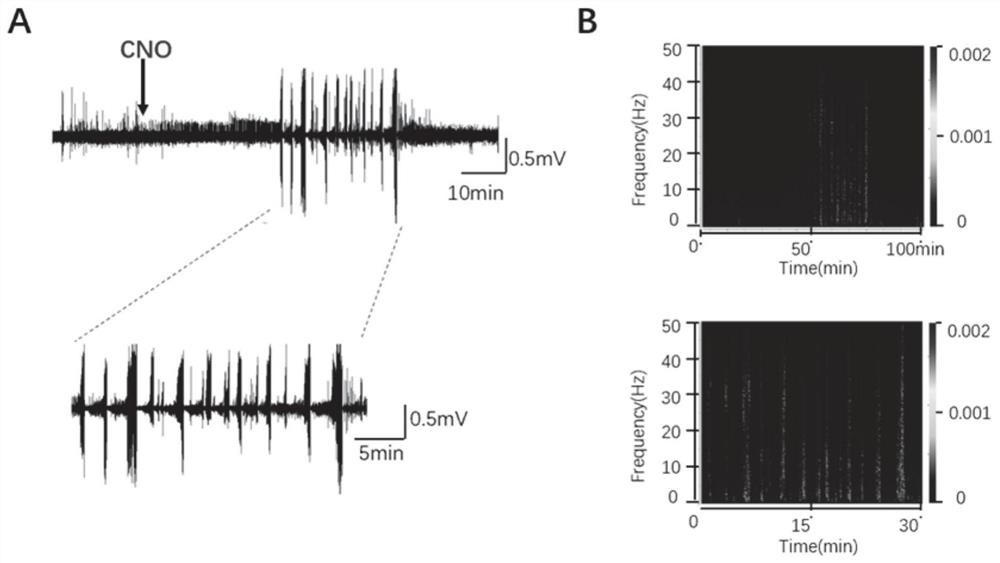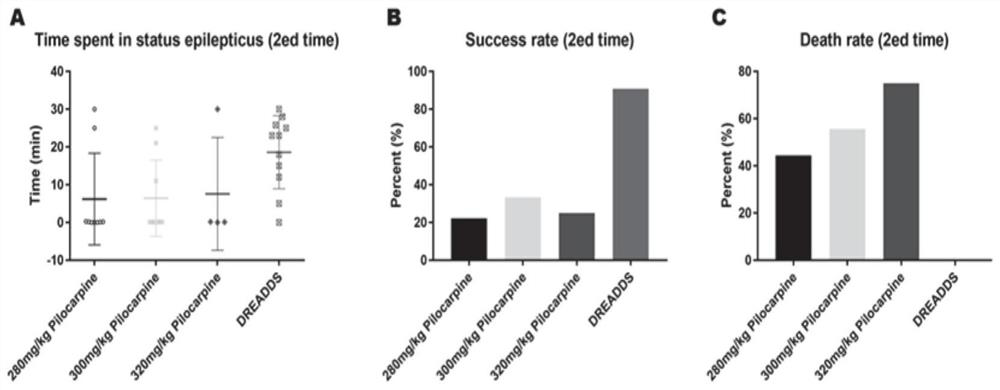Chemical heredity epilepsy persistent state disease animal model and construction method and application thereof
A technology of status epilepticus and animal models, which is applied in the field of chemical genetic status epilepticus disease animal models and its construction, which can solve the problems of neuron death, high mortality, and inability to clarify the origin of status epilepticus lesions
- Summary
- Abstract
- Description
- Claims
- Application Information
AI Technical Summary
Problems solved by technology
Method used
Image
Examples
Embodiment 1
[0047] A method for constructing an animal model of chemical genetic status epilepticus
[0048] 1. Experimental animals
[0049] A total of 24 C57 mice aged 6-8 weeks were selected for this experiment, 12 each in Model 1 and Model 2. Among them, model 1 and model 2 are independent of each other, and model 1 induces status epilepticus by simultaneously activating excitatory neurons in hippocampal CA1 area (1.5, 2.0, 1.4) and ventral anterior nucleus VA area (1.25, 0.94, 3.75) through chemical genetics In the second model, status epilepticus was induced by simultaneously activating excitatory neurons in the BLA region of the amygdala (3.0, 2.0, 4.6) and the VA region of the ventral anterior nucleus of the thalamus (1.25, 0.94, 3.75).
[0050] 2. Experimental method
[0051] 2.1 Virus injection
[0052] 2.1.1 Routine treatment before operation
[0053] C57 mice were anesthetized by intraperitoneal injection of 1% pentobarbital sodium and fixed on a brain stereotaxic device (...
Embodiment 2
[0072] Comparison of chemical genetic status epilepticus disease animal model and Pilocarpine status epilepticus animal model
[0073] 1. Experimental animals
[0074] In this experiment, a total of 36 C57 mice aged 6-8 weeks were selected and divided into 3 groups with 12 mice in each group. The chemical genetic status epilepticus disease animal model in step 2.5 in Example 1 was selected.
[0075] 2. Experimental method
[0076] The construction of the animal model of Pilocarpine status epilepticus: commonly used Pilocarpine doses: 280mg / kg, 300mg / kg, 320mg / kg, 12 mice in each group, intraperitoneal injection of Pilocarpine to induce status epilepticus, and then statistics were made for each group Seizure duration within 30 minutes (min) from the onset of onset, and the final total model establishment success rate and mortality rate, the chemical genetic epilepsy constructed by the Pilocarpine epilepsy still needing state animal model and the condition of step 2.5 in Exampl...
Embodiment 3
[0084] Repeat induction experiment
[0085] 1. Experimental animals
[0086] The chemical genetic status epilepticus disease animal model constructed under the conditions of step 2.5 in Example 1, the Pilocarpine status epilepticus animal model constructed in Example 2
[0087] 2. Experimental method
[0088] With the chemical genetic status epilepticus disease animal model constructed under the conditions of step 2.5 in Example 1, with the Pilocarpine status epilepticus animal model constructed under the test conditions in Example 2, the same group of mice was subjected to the same test every other week. The induction experiment was repeated for a total of 4 experiments.
[0089] Table 3 Comparison of repeated induction duration between Pilocarpine animal model of status epilepticus and chemical genetic status epilepticus disease animal model
[0090]
[0091] Table 4 Comparison of repeated induction success rate and mortality between Pilocarpine animal model of status ...
PUM
 Login to View More
Login to View More Abstract
Description
Claims
Application Information
 Login to View More
Login to View More - R&D
- Intellectual Property
- Life Sciences
- Materials
- Tech Scout
- Unparalleled Data Quality
- Higher Quality Content
- 60% Fewer Hallucinations
Browse by: Latest US Patents, China's latest patents, Technical Efficacy Thesaurus, Application Domain, Technology Topic, Popular Technical Reports.
© 2025 PatSnap. All rights reserved.Legal|Privacy policy|Modern Slavery Act Transparency Statement|Sitemap|About US| Contact US: help@patsnap.com



